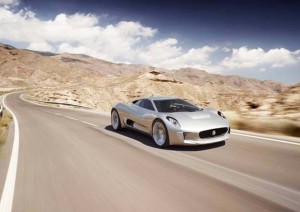
A production version of the striking C-X75 concept would push the number of new Jaguar models and variants to 41.
It has been a roller-coaster ride for Jaguar over the last 15 years, but now part of the ambitious Indian Tata Motors, the British automaker has some ambitious plans in the work along with its sibling Land Rover brand.
Senior company officials tell TheDetroitBureau.com that the two brands will jointly be launching a major product assault over the next five years with the goal of lifting Jaguar and Land Rover out of their low-volume niches and planting them much more firmly in the luxury mainstream.
“We’ll be launching 40 new cars, derivatives and (major) technologies from Jaguar/Land Rover in the next five years,” said Adrian Hallmark, who joined Jaguar as its Global Brand Director last October.
The list of new programs breaks down into three categories:
- Products that slot above and below the current Jaguar and Land Rover line-up, as well as those that broaden the current line-up’s appeal;
- Products that can expand the appeal of the two brands in markets where they currently don’t have a presence;
- Technologies that expand the capabilities of the two brands — possibly including new diesels, hybrids and other advanced propulsion systems.
Among the many products under development, he confirmed, is a new entry-luxury model that will slip in below the current XF model. Don’t call it a replacement for the old X-Type, however. That model was, to Hallmark, symptomatic of the many mistakes Jaguar made while under the ownership of Ford Motor Co. The old X-Type was little more than a rebadged Ford, developed with the goal of delivering a big increase in volume even though it didn’t really fit the brand.
The new small car, along with everything else to follow, stressed the British-born executive, will have to deliver the look, the feel and the performance that fits the brand.
Replacing the unloved X-Type is essential, added Hallmark, as “That segment is massive,” and could become “the most important piece” of Jaguar’s planned product expansion effort. A sedan is a must off the new platform, but other variants may follow.
“Could we do other body styles?” Hallmark asked before delivering the answer, “We’d love to do multiple body styles.”
Asked what else is coming, Hallmark suggested that a higher-end crossover, targeting the likes of a BMW X5 or Audi Q7, is a definite addition under development, while he hints a smaller crossover is a strong possibility, as well. That’s a distinct shift in strategy as Jaguar has long steered clear of anything truck-like, yielding that part of the market to Land Rover.
But the thinking is that, “Just because we’re part of Jaguar/Land Rover doesn’t mean we can’t look at crossovers,” said Hallmark, who joined the British maker last October after a brief stint with the reborn Saab.
“We will not overlap,” echoed Dr. Ralf Speth, the Jaguar Land Rover CEO, in a separate interview, insisting that there will be “distinct DNA” that won’t let customers confuse crossovers sold by the two brands – which will maintain separate showrooms going forward.
Hallmark also suggests that while the new small luxury car will take Jaguar below its current range, “We can also (extend) above where we are now.”
What’s not on the planning board – for now – is the C-X75 supercar concept revealed at last year’s Paris Motor Show. The striking prototype was powered by an unusual range-extender drivetrain using a pair of microhybrids to generate electric power once its batteries ran down. The concept is viable, noted Hallmark, but would require tremendous work to bring to market and though research is underway, it is not an approved program. If it does get the go, the C-X75 “would be 41,” a reference to the 40 other programs not approved.
Electrification apparently does have a place in Jaguar’s future product portfolio. Though company officials were vague on specifics, Speth hinted that pure, battery-powered models “are not the only way to go,” suggesting more conventional hybrids and plug-ins are a more likely focus.
One form or another, adding new powertrains will be just as critical to both Jaguar and Land Rover as all-new models, stressed J/LR CEO Speth, who confirmed the addition of a 2.2-liter diesel to the XF range.
While Jaguar might not have an unlimited budget, it’s in a decidedly better position than it was just three years ago, emphasized Hallmark, insisting “It’s gone from survival to unbridled ambition in three years.”
To help fund the ambitious product program at Jaguar/Land Rover, Tata is reportedly preparing to sell a large global bond issue in the coming months, with J.P, Morgan Chase, Citigroup, Credit Suisse Group and Standard Chartered PLC hired to manage the deal. While the British operations are now operating in the black, the bonds would help offset the cost of Tata’s $2.3 billion acquisition and free up more funds for R&D.
At one point, former Ford CEO Jacques Nasser laid out plans that could push Jaguar sales to 200,000 a year and beyond. Today, however, it is barely at the 50,000 mark. The product offensive could transform the maker from a niche player to something more on a par with its German rivals, though “We won’t be selling 1 million Jaguars a year,” Hallmark cautioned. “But we want to sell big multiples” of the current numbers…a lot more than today.”
